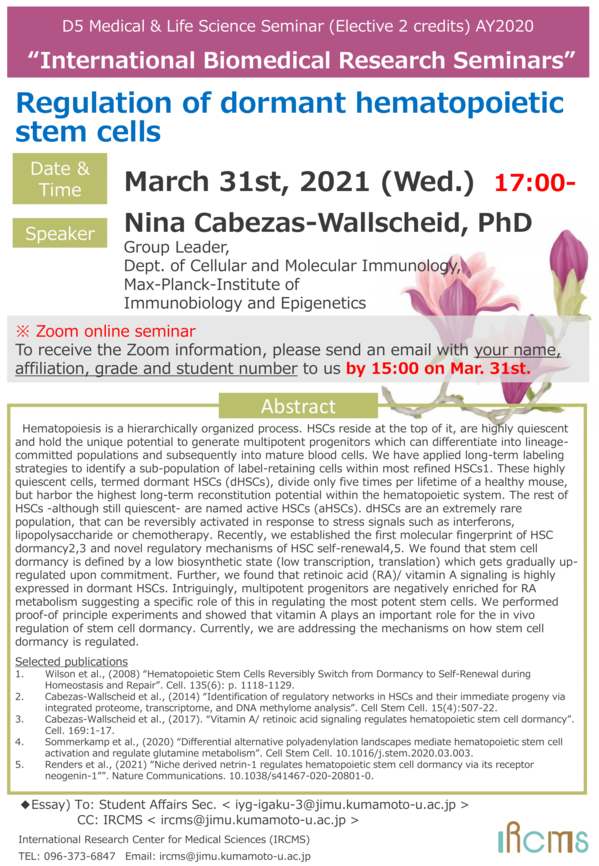- HOME
- News & Events
- [Mar.31] D5 Medical & Life Science Seminar-Dr. Nina Cabezas-Wallscheid
News & Events
[Mar.31] D5 Medical & Life Science Seminar-Dr. Nina Cabezas-Wallscheid
March 18 2021
The "D5 Medical & Life Science Seminar" course will be offered by International Research Center for Medical Sciences (IRCMS). It will run from April 2020 to March 2021, with lectures given by scientists who are affiliated with IRCMS or in collaboration with researchers at IRCMS. The lectures will be given once a month, in English, and by leading scientists in the relevant research field. Students will be taught: 1) how normal physiological functions are maintained in the human body; 2) how these systems become abnormal under certain pathophysiologic conditions; 3) why stem cells are important in animal development and homeostasis; 4) how stem cell-based approaches can help us understand disease mechanisms and find potential cure for diseases related to stem cell malfunction (e.g., cancer, aging).
Date : March 31, 2021 (Wednesday)
Time : 17:00 -
* Zoom online seminar
To receive the meeting ID / Password, please send an email to
ircms*jimu.kumamoto-u.ac.jp by 15:00 on March 31, 2021.
(Change * to @ when you send an email.)
Please include your name, affiliation, grade and student number in your email.
Speaker : Nina Cabezas-Wallscheid, PhD
Group Leader,
Department of Cellular and Molecular Immunology,
Max-Planck-Institute of Immunobiology and Epigenetics
Title : Regulation of dormant hematopoietic stem cells
Abstract :
Hematopoiesis is a hierarchically organized process. HSCs reside at the top of it, are highly quiescent and hold the unique potential to generate multipotent progenitors which can differentiate into lineage-committed populations and subsequently into mature blood cells. We have applied long-term labeling strategies to identify a sub-population of label-retaining cells within most refined HSCs1. These highly quiescent cells, termed dormant HSCs (dHSCs), divide only five times per lifetime of a healthy mouse, but harbor the highest long-term reconstitution potential within the hematopoietic system. The rest of HSCs -although still quiescent- are named active HSCs (aHSCs). dHSCs are an extremely rare population, that can be reversibly activated in response to stress signals such as interferons, lipopolysaccharide or chemotherapy. Recently, we established the first molecular fingerprint of HSC dormancy2,3 and novel regulatory mechanisms of HSC self-renewal4,5. We found that stem cell dormancy is defined by a low biosynthetic state (low transcription, translation) which gets gradually up-regulated upon commitment. Further, we found that retinoic acid (RA)/ vitamin A signaling is highly expressed in dormant HSCs. Intriguingly, multipotent progenitors are negatively enriched for RA metabolism suggesting a specific role of this in regulating the most potent stem cells. We performed proof-of principle experiments and showed that vitamin A plays an important role for the in vivo regulation of stem cell dormancy. Currently, we are addressing the mechanisms on how stem cell dormancy is regulated.
Selected publications:
- Wilson et al., (2008) "Hematopoietic Stem Cells Reversibly Switch from Dormancy to Self-Renewal during Homeostasis and Repair". Cell. 135(6): p. 1118-1129.
- Cabezas-Wallscheid et al., (2014) "Identification of regulatory networks in HSCs and their immediate progeny via integrated proteome, transcriptome, and DNA methylome analysis". Cell Stem Cell. 15(4):507-22.
- Cabezas-Wallscheid et al., (2017). "Vitamin A/ retinoic acid signaling regulates hematopoietic stem cell dormancy". Cell. 169:1-17.
- Sommerkamp et al., (2020) "Differential alternative polyadenylation landscapes mediate hematopoietic stem cell activation and regulate glutamine metabolism". Cell Stem Cell. 10.1016/j.stem.2020.03.003.
- Renders et al., (2021) "Niche derived netrin-1 regulates hematopoietic stem cell dormancy via its receptor neogenin-1"". Nature Communications. 10.1038/s41467-020-20801-0.
Flyer: (Click for a larger image)

